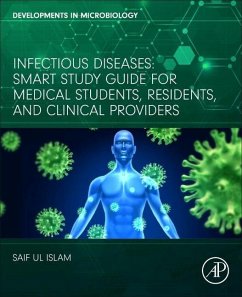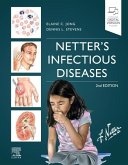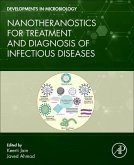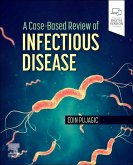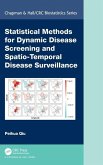Saif ul Islam (MD., RPh., BCPS, Adventist Hospital, California, USA
Infectious Diseases
Smart Study Guide for Medical Students, Residents, and Clinical Providers
Saif ul Islam (MD., RPh., BCPS, Adventist Hospital, California, USA
Infectious Diseases
Smart Study Guide for Medical Students, Residents, and Clinical Providers
- Broschiertes Buch
- Merkliste
- Auf die Merkliste
- Bewerten Bewerten
- Teilen
- Produkt teilen
- Produkterinnerung
- Produkterinnerung
Infectious Diseases: Smart Study Guide for Medical Students, Residents, Physicians and Clinical Pharmacists attempts to consolidate knowledge and information into a step-by-step process that would be easy to understand, remember, and apply in a clinical setting. High-yield information presented in this book is necessary for medical students and residents. This book has provided information for all disciplines working in infectious diseases, whether students, residents, physicians, pharmacists, or nurses. The book is organized for quick and easy to retrieve information for all professionals.
Andere Kunden interessierten sich auch für
![Early Warning for Infectious Disease Outbreak Early Warning for Infectious Disease Outbreak]() Weizhong Yang (Deputy director of Chinese Center for Dis ProfessorEarly Warning for Infectious Disease Outbreak143,99 €
Weizhong Yang (Deputy director of Chinese Center for Dis ProfessorEarly Warning for Infectious Disease Outbreak143,99 €![Netter's Infectious Diseases Netter's Infectious Diseases]() Netter's Infectious Diseases104,99 €
Netter's Infectious Diseases104,99 €![Nanotheranostics for Treatment and Diagnosis of Infectious Diseases Nanotheranostics for Treatment and Diagnosis of Infectious Diseases]() Nanotheranostics for Treatment and Diagnosis of Infectious Diseases152,99 €
Nanotheranostics for Treatment and Diagnosis of Infectious Diseases152,99 €![Of Mice, Men, and Microbes Of Mice, Men, and Microbes]() David R. HarperOf Mice, Men, and Microbes44,99 €
David R. HarperOf Mice, Men, and Microbes44,99 €![A Case-Based Review of Infectious Disease A Case-Based Review of Infectious Disease]() Pujagic, Edin, DO (Department of Internal Infectious Disease FellowA Case-Based Review of Infectious Disease119,99 €
Pujagic, Edin, DO (Department of Internal Infectious Disease FellowA Case-Based Review of Infectious Disease119,99 €![Statistical Methods for Dynamic Disease Screening and Spatio-Temporal Disease Surveillance Statistical Methods for Dynamic Disease Screening and Spatio-Temporal Disease Surveillance]() Peihua QiuStatistical Methods for Dynamic Disease Screening and Spatio-Temporal Disease Surveillance116,99 €
Peihua QiuStatistical Methods for Dynamic Disease Screening and Spatio-Temporal Disease Surveillance116,99 €![Emerging and Re-Emerging Infectious Diseases, An Issue of Physician Assistant Clinics Emerging and Re-Emerging Infectious Diseases, An Issue of Physician Assistant Clinics]() Emerging and Re-Emerging Infectious Diseases, An Issue of Physician Assistant Clinics46,99 €
Emerging and Re-Emerging Infectious Diseases, An Issue of Physician Assistant Clinics46,99 €-
-
-
Infectious Diseases: Smart Study Guide for Medical Students, Residents, Physicians and Clinical Pharmacists attempts to consolidate knowledge and information into a step-by-step process that would be easy to understand, remember, and apply in a clinical setting. High-yield information presented in this book is necessary for medical students and residents. This book has provided information for all disciplines working in infectious diseases, whether students, residents, physicians, pharmacists, or nurses. The book is organized for quick and easy to retrieve information for all professionals.
Hinweis: Dieser Artikel kann nur an eine deutsche Lieferadresse ausgeliefert werden.
Hinweis: Dieser Artikel kann nur an eine deutsche Lieferadresse ausgeliefert werden.
Produktdetails
- Produktdetails
- Developments in Microbiology
- Verlag: Elsevier Science Publishing Co Inc
- Seitenzahl: 420
- Erscheinungstermin: 3. Mai 2023
- Englisch
- Abmessung: 191mm x 234mm x 34mm
- Gewicht: 876g
- ISBN-13: 9780443187421
- ISBN-10: 0443187428
- Artikelnr.: 64143285
- Herstellerkennzeichnung
- Libri GmbH
- Europaallee 1
- 36244 Bad Hersfeld
- gpsr@libri.de
- Developments in Microbiology
- Verlag: Elsevier Science Publishing Co Inc
- Seitenzahl: 420
- Erscheinungstermin: 3. Mai 2023
- Englisch
- Abmessung: 191mm x 234mm x 34mm
- Gewicht: 876g
- ISBN-13: 9780443187421
- ISBN-10: 0443187428
- Artikelnr.: 64143285
- Herstellerkennzeichnung
- Libri GmbH
- Europaallee 1
- 36244 Bad Hersfeld
- gpsr@libri.de
Dr. Saif ul Islam is a medical doctor and a clinical pharmacist with years of clinical and teaching experience in inpatient and outpatient settings. He received his medical degree in Europe and pharmacy degree in the United States. He did his medical clerkship at Beth Israel Medical Center (Harvard Medical School). He is a board-certified pharmacotherapy specialist, a clinical consultant, and the author of several publications published in several prestigious journals like The Lancet and Medicine. He has worked in various hospitals and pharmacies. His subspecialty is infectious diseases.
Preface Common laboratories values
1. Introduction of infectious diseases 1.1 Bacterial cell 1.2 Difference
between gram-positive and gram-negative bacteria 1.3 Classification 1.4
Gram staining 1.5 Bacterial pathogenicity 1.6 Normal flora 1.7
Manifestations of infection 1.8 Basic immunology 1.9 Major
histocompatibility complex 1.10 Complement system 1.11 Identification of
microorganisms 1 Further reading
2. Gram-positive bacteria 2.0 General Description 2.1 Classification of
Gram-positive bacteria 2.2 Gram-positive cocci 2.3 Gram-positive bacilli
2.4 Summary of gram positive bacteria Further reading
3. Anaerobic bacteria 3.1 Classification 3.2 Gram-positive anaerobic cocci
3.3 Gram-positive anaerobic bacilli 3.4 Summary of anaerobic bacteria and
selection of antibiotics Further reading
4. Gram-negative bacteria 4.1 Classification 4.2 Gram-negative cocci 4.3
Gram-negative bacilli 4.4 Obligate intracellular bacteria 4.5 Spirochetes
4.6 Acid-fast bacteria 4.7 Bacteria with no cell wall 4.8 Summary of
gram-negative bacteria and choice of antibiotics Further reading
5. Antibacterial drugs 5.1 Classification 5.2 Beta-lactam 5.3 Carbapenems
5.4 Monobactam 5.5 Lipoglycopeptide 5.6 Linezolid 5.7 Daptomycin 5.8
Inhibitor of protein synthesis in bacterial cell 5.9 Metronidazole 5.10 DNA
gyrase and topoisomerase inhibitors 5.11 Folic acid inhibitors 5.12
Miscellaneous 5.13 Antibiotics for high resistance bacteria 5.14
Antipseudomonal antibiotic 5.15 Antibiotics for anaerobic bacteria 5.16
Bacterial resistance 5.17 Resistance to beta-lactam 5.18 Antibacterial
activity spectrum Further reading
6. Viruses 6.1 Description 6.2 Classification 6.3 Respiratory viruses 6.4
Viruses associated with gastroenteritis 6.5 Exanthematous viruses 6.6
Enterovirus 6.7 Hepatitis 6.8 Viruses infect CNS 6.9 Viruses causing
meningitis/encephalitis 6.10 Viruses causing hemorrhagic fever 6.11 -
Viruses infecting skin or mucus membrane 6.12 Other herpes viruses 6.13
Acquired immune deficiency 6.14 HIV antiviral drugs 6.15 NoneHIV antiviral
drugs 6.16 Summary of viral infection Further reading
7. Fungus 7.1 Fungal cell 7.2 Classification 7.3 Yeast 7.4 Molds 7.5
Dimorphic fungus 7.6 Dermatophytes 7.7 Summary 7.8 Antifungal drugs 7.9
Quick reference of antifungal drugs Further reading
8. Parasitic infections 8.1 Classification 8.2 Protozoa 8.3 Microsporidia
8.4 Helminths 8.5 Antiparasitic drugs Further reading
9. Common infections caused by multiple microorganisms 9.1 Respiratory
infection 9.2 Meningitis 9.3 Encephalitis 9.4 Brain abscess 9.5 Bacteremia
9.6 Sepsis and septic shock 9.7 Cardiovascular infection 9.8 Urinary tract
infection 9.9 Gastro-intestinal infection 9.10 Ear infection 9.11 Nasal
infection 9.12 Eye infections 9.13 Skin infection 9.14 Bone infection 9.15
Fever of unknown origin (FUO) 9.16 Sexually transmitted diseases 9.17 Prion
9.18 Quick reference of common infections, pathogens, and treatments
Further reading
10. Drugs, dosages, side effects, and pregnancy catagory Further reading
Index
1. Introduction of infectious diseases 1.1 Bacterial cell 1.2 Difference
between gram-positive and gram-negative bacteria 1.3 Classification 1.4
Gram staining 1.5 Bacterial pathogenicity 1.6 Normal flora 1.7
Manifestations of infection 1.8 Basic immunology 1.9 Major
histocompatibility complex 1.10 Complement system 1.11 Identification of
microorganisms 1 Further reading
2. Gram-positive bacteria 2.0 General Description 2.1 Classification of
Gram-positive bacteria 2.2 Gram-positive cocci 2.3 Gram-positive bacilli
2.4 Summary of gram positive bacteria Further reading
3. Anaerobic bacteria 3.1 Classification 3.2 Gram-positive anaerobic cocci
3.3 Gram-positive anaerobic bacilli 3.4 Summary of anaerobic bacteria and
selection of antibiotics Further reading
4. Gram-negative bacteria 4.1 Classification 4.2 Gram-negative cocci 4.3
Gram-negative bacilli 4.4 Obligate intracellular bacteria 4.5 Spirochetes
4.6 Acid-fast bacteria 4.7 Bacteria with no cell wall 4.8 Summary of
gram-negative bacteria and choice of antibiotics Further reading
5. Antibacterial drugs 5.1 Classification 5.2 Beta-lactam 5.3 Carbapenems
5.4 Monobactam 5.5 Lipoglycopeptide 5.6 Linezolid 5.7 Daptomycin 5.8
Inhibitor of protein synthesis in bacterial cell 5.9 Metronidazole 5.10 DNA
gyrase and topoisomerase inhibitors 5.11 Folic acid inhibitors 5.12
Miscellaneous 5.13 Antibiotics for high resistance bacteria 5.14
Antipseudomonal antibiotic 5.15 Antibiotics for anaerobic bacteria 5.16
Bacterial resistance 5.17 Resistance to beta-lactam 5.18 Antibacterial
activity spectrum Further reading
6. Viruses 6.1 Description 6.2 Classification 6.3 Respiratory viruses 6.4
Viruses associated with gastroenteritis 6.5 Exanthematous viruses 6.6
Enterovirus 6.7 Hepatitis 6.8 Viruses infect CNS 6.9 Viruses causing
meningitis/encephalitis 6.10 Viruses causing hemorrhagic fever 6.11 -
Viruses infecting skin or mucus membrane 6.12 Other herpes viruses 6.13
Acquired immune deficiency 6.14 HIV antiviral drugs 6.15 NoneHIV antiviral
drugs 6.16 Summary of viral infection Further reading
7. Fungus 7.1 Fungal cell 7.2 Classification 7.3 Yeast 7.4 Molds 7.5
Dimorphic fungus 7.6 Dermatophytes 7.7 Summary 7.8 Antifungal drugs 7.9
Quick reference of antifungal drugs Further reading
8. Parasitic infections 8.1 Classification 8.2 Protozoa 8.3 Microsporidia
8.4 Helminths 8.5 Antiparasitic drugs Further reading
9. Common infections caused by multiple microorganisms 9.1 Respiratory
infection 9.2 Meningitis 9.3 Encephalitis 9.4 Brain abscess 9.5 Bacteremia
9.6 Sepsis and septic shock 9.7 Cardiovascular infection 9.8 Urinary tract
infection 9.9 Gastro-intestinal infection 9.10 Ear infection 9.11 Nasal
infection 9.12 Eye infections 9.13 Skin infection 9.14 Bone infection 9.15
Fever of unknown origin (FUO) 9.16 Sexually transmitted diseases 9.17 Prion
9.18 Quick reference of common infections, pathogens, and treatments
Further reading
10. Drugs, dosages, side effects, and pregnancy catagory Further reading
Index
Preface Common laboratories values
1. Introduction of infectious diseases 1.1 Bacterial cell 1.2 Difference
between gram-positive and gram-negative bacteria 1.3 Classification 1.4
Gram staining 1.5 Bacterial pathogenicity 1.6 Normal flora 1.7
Manifestations of infection 1.8 Basic immunology 1.9 Major
histocompatibility complex 1.10 Complement system 1.11 Identification of
microorganisms 1 Further reading
2. Gram-positive bacteria 2.0 General Description 2.1 Classification of
Gram-positive bacteria 2.2 Gram-positive cocci 2.3 Gram-positive bacilli
2.4 Summary of gram positive bacteria Further reading
3. Anaerobic bacteria 3.1 Classification 3.2 Gram-positive anaerobic cocci
3.3 Gram-positive anaerobic bacilli 3.4 Summary of anaerobic bacteria and
selection of antibiotics Further reading
4. Gram-negative bacteria 4.1 Classification 4.2 Gram-negative cocci 4.3
Gram-negative bacilli 4.4 Obligate intracellular bacteria 4.5 Spirochetes
4.6 Acid-fast bacteria 4.7 Bacteria with no cell wall 4.8 Summary of
gram-negative bacteria and choice of antibiotics Further reading
5. Antibacterial drugs 5.1 Classification 5.2 Beta-lactam 5.3 Carbapenems
5.4 Monobactam 5.5 Lipoglycopeptide 5.6 Linezolid 5.7 Daptomycin 5.8
Inhibitor of protein synthesis in bacterial cell 5.9 Metronidazole 5.10 DNA
gyrase and topoisomerase inhibitors 5.11 Folic acid inhibitors 5.12
Miscellaneous 5.13 Antibiotics for high resistance bacteria 5.14
Antipseudomonal antibiotic 5.15 Antibiotics for anaerobic bacteria 5.16
Bacterial resistance 5.17 Resistance to beta-lactam 5.18 Antibacterial
activity spectrum Further reading
6. Viruses 6.1 Description 6.2 Classification 6.3 Respiratory viruses 6.4
Viruses associated with gastroenteritis 6.5 Exanthematous viruses 6.6
Enterovirus 6.7 Hepatitis 6.8 Viruses infect CNS 6.9 Viruses causing
meningitis/encephalitis 6.10 Viruses causing hemorrhagic fever 6.11 -
Viruses infecting skin or mucus membrane 6.12 Other herpes viruses 6.13
Acquired immune deficiency 6.14 HIV antiviral drugs 6.15 NoneHIV antiviral
drugs 6.16 Summary of viral infection Further reading
7. Fungus 7.1 Fungal cell 7.2 Classification 7.3 Yeast 7.4 Molds 7.5
Dimorphic fungus 7.6 Dermatophytes 7.7 Summary 7.8 Antifungal drugs 7.9
Quick reference of antifungal drugs Further reading
8. Parasitic infections 8.1 Classification 8.2 Protozoa 8.3 Microsporidia
8.4 Helminths 8.5 Antiparasitic drugs Further reading
9. Common infections caused by multiple microorganisms 9.1 Respiratory
infection 9.2 Meningitis 9.3 Encephalitis 9.4 Brain abscess 9.5 Bacteremia
9.6 Sepsis and septic shock 9.7 Cardiovascular infection 9.8 Urinary tract
infection 9.9 Gastro-intestinal infection 9.10 Ear infection 9.11 Nasal
infection 9.12 Eye infections 9.13 Skin infection 9.14 Bone infection 9.15
Fever of unknown origin (FUO) 9.16 Sexually transmitted diseases 9.17 Prion
9.18 Quick reference of common infections, pathogens, and treatments
Further reading
10. Drugs, dosages, side effects, and pregnancy catagory Further reading
Index
1. Introduction of infectious diseases 1.1 Bacterial cell 1.2 Difference
between gram-positive and gram-negative bacteria 1.3 Classification 1.4
Gram staining 1.5 Bacterial pathogenicity 1.6 Normal flora 1.7
Manifestations of infection 1.8 Basic immunology 1.9 Major
histocompatibility complex 1.10 Complement system 1.11 Identification of
microorganisms 1 Further reading
2. Gram-positive bacteria 2.0 General Description 2.1 Classification of
Gram-positive bacteria 2.2 Gram-positive cocci 2.3 Gram-positive bacilli
2.4 Summary of gram positive bacteria Further reading
3. Anaerobic bacteria 3.1 Classification 3.2 Gram-positive anaerobic cocci
3.3 Gram-positive anaerobic bacilli 3.4 Summary of anaerobic bacteria and
selection of antibiotics Further reading
4. Gram-negative bacteria 4.1 Classification 4.2 Gram-negative cocci 4.3
Gram-negative bacilli 4.4 Obligate intracellular bacteria 4.5 Spirochetes
4.6 Acid-fast bacteria 4.7 Bacteria with no cell wall 4.8 Summary of
gram-negative bacteria and choice of antibiotics Further reading
5. Antibacterial drugs 5.1 Classification 5.2 Beta-lactam 5.3 Carbapenems
5.4 Monobactam 5.5 Lipoglycopeptide 5.6 Linezolid 5.7 Daptomycin 5.8
Inhibitor of protein synthesis in bacterial cell 5.9 Metronidazole 5.10 DNA
gyrase and topoisomerase inhibitors 5.11 Folic acid inhibitors 5.12
Miscellaneous 5.13 Antibiotics for high resistance bacteria 5.14
Antipseudomonal antibiotic 5.15 Antibiotics for anaerobic bacteria 5.16
Bacterial resistance 5.17 Resistance to beta-lactam 5.18 Antibacterial
activity spectrum Further reading
6. Viruses 6.1 Description 6.2 Classification 6.3 Respiratory viruses 6.4
Viruses associated with gastroenteritis 6.5 Exanthematous viruses 6.6
Enterovirus 6.7 Hepatitis 6.8 Viruses infect CNS 6.9 Viruses causing
meningitis/encephalitis 6.10 Viruses causing hemorrhagic fever 6.11 -
Viruses infecting skin or mucus membrane 6.12 Other herpes viruses 6.13
Acquired immune deficiency 6.14 HIV antiviral drugs 6.15 NoneHIV antiviral
drugs 6.16 Summary of viral infection Further reading
7. Fungus 7.1 Fungal cell 7.2 Classification 7.3 Yeast 7.4 Molds 7.5
Dimorphic fungus 7.6 Dermatophytes 7.7 Summary 7.8 Antifungal drugs 7.9
Quick reference of antifungal drugs Further reading
8. Parasitic infections 8.1 Classification 8.2 Protozoa 8.3 Microsporidia
8.4 Helminths 8.5 Antiparasitic drugs Further reading
9. Common infections caused by multiple microorganisms 9.1 Respiratory
infection 9.2 Meningitis 9.3 Encephalitis 9.4 Brain abscess 9.5 Bacteremia
9.6 Sepsis and septic shock 9.7 Cardiovascular infection 9.8 Urinary tract
infection 9.9 Gastro-intestinal infection 9.10 Ear infection 9.11 Nasal
infection 9.12 Eye infections 9.13 Skin infection 9.14 Bone infection 9.15
Fever of unknown origin (FUO) 9.16 Sexually transmitted diseases 9.17 Prion
9.18 Quick reference of common infections, pathogens, and treatments
Further reading
10. Drugs, dosages, side effects, and pregnancy catagory Further reading
Index

